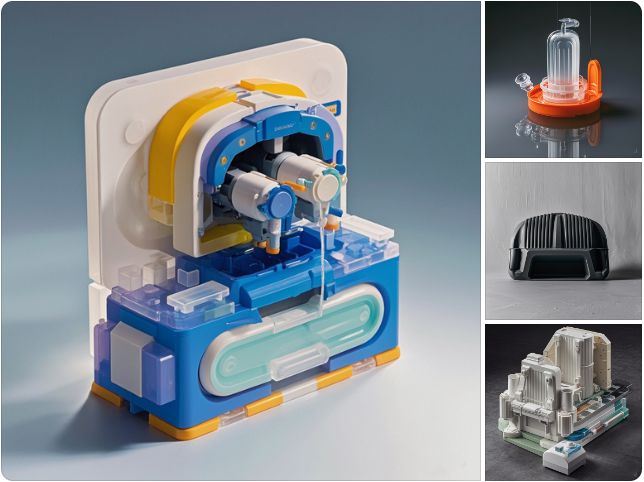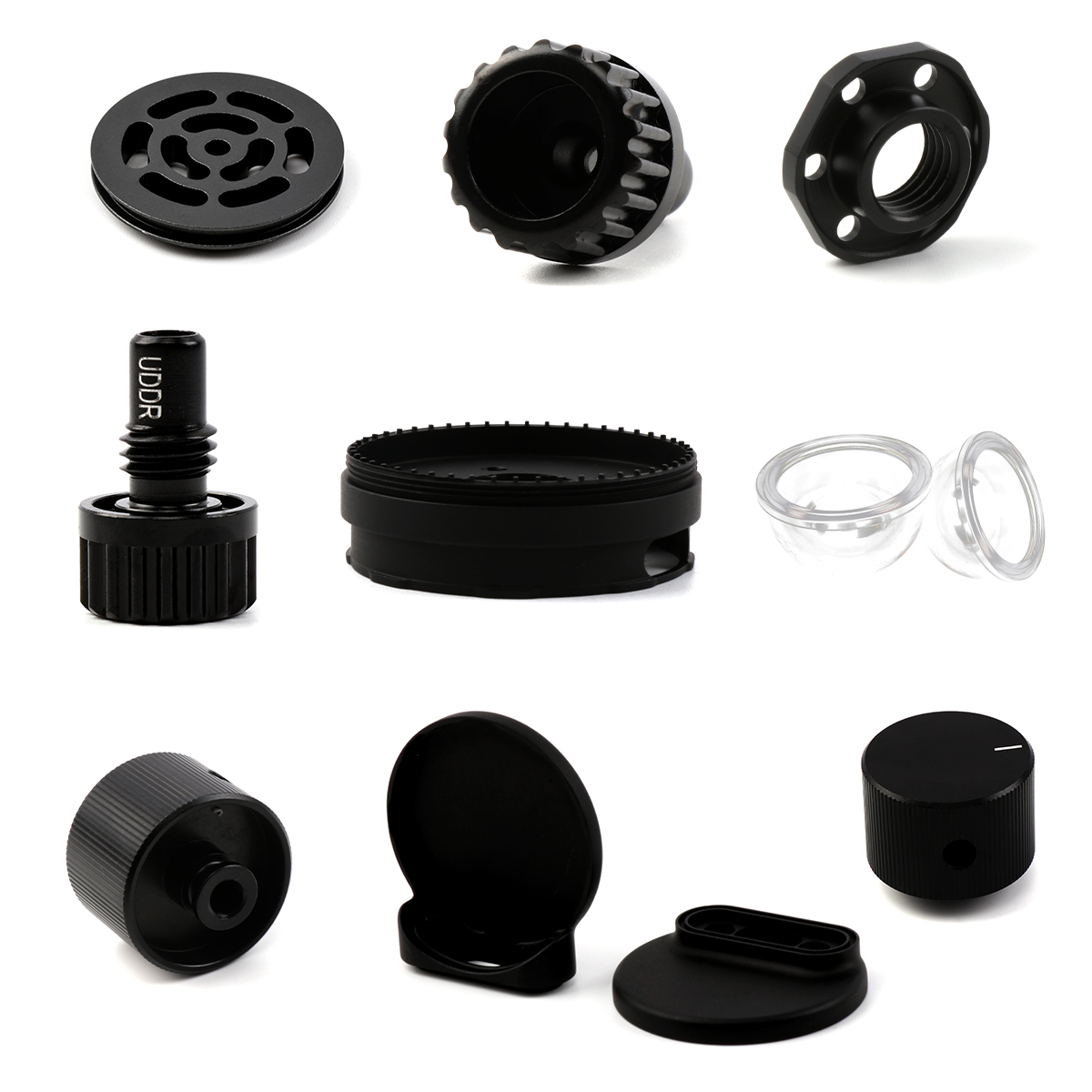News
Plastic molding: definition, purpose, working principle, advantages and examples
What is plastic molding?
Plastic molding is a manufacturing process for creating plastic parts by shaping liquid or pliable raw plastic using a rigid frame called a mold or matrix. This process is widely used to produce a wide variety of plastic components, ranging from small parts to large items.
Definition
Plastic molding is the process of shaping plastic materials into desired forms using a mold. The raw plastic is heated until it becomes liquid or pliable and then injected or pressed into a mold where it cools and solidifies into the final shape.
Purpose
The primary purpose of plastic molding is to produce consistent and high-quality plastic parts efficiently. It is used in various industries, including automotive, aerospace, consumer goods, electronics, and medical devices, to manufacture parts with precise dimensions and complex shapes.

The term "plastic fabrication" describes the process of creating, producing, and/or assembling custom-designed plastic products or high volume parts out of plastic or composite materials. Plastic fabrication includes a variety of processes, such as:
1. Plastic extrusion
2. Plastic pultrusion
3. Plastic welding
4. Thermoforming
5. Injection molding
6. Rotational molding
7. Blow molding
8. Plastic CNC machining
10. Stereolithography
11. Fused deposition modeling
12. Selective laser sintering
How It Works?
- Designing the Mold: A mold is designed based on the desired shape of the final product. It usually consists of two halves that form a cavity in the shape of the part.
- Heating the Plastic: Plastic material (in the form of pellets or powder) is heated until it becomes liquid or pliable.
- Filling the Mold: The liquid plastic is injected or poured into the mold cavity.
- Cooling: The plastic cools and solidifies inside the mold.
- Ejecting the Part: The mold is opened, and the finished part is ejected.
Advantages
- High Efficiency: Large quantities of parts can be produced quickly.
- Consistency: Parts produced are highly consistent in shape and size.
- Complex Shapes: Allows for the production of complex and intricate shapes that would be difficult or impossible to achieve with other manufacturing methods.
- Material Versatility: Can be used with a wide range of plastic materials, each with different properties.
Examples
- Injection Molding: Widely used for producing a variety of items from small components to large body panels.
- Blow Molding: Used for making hollow plastic parts like bottles and containers.
- Compression Molding: Often used for larger and thicker parts such as automotive components.
- Rotational Molding: Used for producing large, hollow, and seamless parts like tanks and playground equipment.
Plastic molding is an essential process in modern manufacturing, enabling the production of a vast array of products with efficiency and precision.
Why choose plastic molding and what advantages does it have?
- High Efficiency and Speed: Plastic molding processes, especially injection molding, are highly efficient and can produce large quantities of parts quickly. This is ideal for mass production.
- Cost-Effective for Large Volumes: Once the initial mold is created, the per-unit cost of production is relatively low, making it cost-effective for high-volume manufacturing.
- Design Flexibility: Plastic molding allows for complex and intricate designs that would be difficult or impossible to achieve with other manufacturing methods.
- Consistency and Precision: Molding ensures high precision and repeatability, producing parts that are consistent in quality and dimensions.
- Wide Range of Materials: A variety of plastic materials can be used, each with different properties, allowing manufacturers to choose the best material for their specific application.
- Reduced Waste: Modern plastic molding processes are designed to minimize waste, with excess material often being recyclable.
Advantages of Plastic Molding
- High Production Rates: Molding can produce thousands or even millions of parts with high accuracy and consistency.
- Low Labor Costs: Once set up, the process requires minimal human intervention, reducing labor costs.
- Material Efficiency: Plastic molding uses materials efficiently, with minimal waste produced during the process.
- Enhanced Strength: Molded plastic parts can be reinforced with fillers to improve their strength and durability without significantly increasing weight.
- Surface Finish Options: Molding can produce parts with a wide range of surface finishes and textures, from smooth and glossy to textured and matte.
- Versatility: The process can create parts of various sizes, shapes, and complexities, from small precision components to large, intricate items.
- Scalability: Molding processes can be scaled up easily to meet increased production demands.
- Automation Potential: Many plastic molding processes can be automated, improving efficiency and reducing the likelihood of human error.
- Customizability: Molds can be designed to include complex features such as undercuts, threads, and multiple cavities, allowing for highly customized products.
Examples of Industries and Products
- Automotive: Dashboards, bumpers, and various internal components.
- Consumer Goods: Toys, household appliances, and electronics casings.
- Medical: Syringes, inhalers, and other medical devices.
- Packaging: Bottles, containers, and caps.
- Construction: Pipes, fittings, and insulation materials.

What is the step-by-step process of plastic manufacturing?
-
Product Design and Development
- Conceptualization: Define the product requirements, functionalities, and specifications.
- CAD Modeling: Create a detailed 3D model of the product using Computer-Aided Design (CAD) software.
- Prototyping: Produce a prototype using 3D printing or other rapid prototyping techniques to validate the design and functionality.
-
Material Selection
- Identify Material Properties: Determine the required properties such as strength, flexibility, thermal resistance, and chemical resistance.
- Select Plastic Material: Choose the appropriate plastic material (e.g., ABS, polycarbonate, polyethylene) based on the product requirements.
-
Mold Design and Manufacturing
- Mold Design: Design the mold based on the 3D model of the product, considering factors such as parting lines, ejector pins, and cooling channels.
- Mold Fabrication: Manufacture the mold using materials like steel or aluminum. This involves precision machining and finishing processes.
-
Plastic Injection Molding Process
- Material Preparation: Plastic pellets or granules are fed into a hopper and heated until they melt.
- Injection: The molten plastic is injected into the mold cavity under high pressure using an injection molding machine.
- Cooling: The mold is cooled to solidify the plastic, typically using water or air cooling systems integrated into the mold.
- Ejection: Once the plastic has cooled and solidified, the mold opens, and the finished part is ejected using ejector pins.
-
Post-Processing
- Trimming and Deflashing: Remove any excess material (flash) from the molded parts.
- Surface Finishing: Apply any necessary surface treatments such as painting, coating, or texturing to achieve the desired finish.
- Assembly: If the product consists of multiple parts, they are assembled into the final product.
-
Quality Control and Inspection
- Dimensional Inspection: Check the dimensions of the molded parts to ensure they meet specifications.
- Functional Testing: Perform tests to ensure the parts meet functional requirements and performance standards.
- Visual Inspection: Inspect the parts for any visual defects such as surface blemishes, warping, or discoloration.
-
Packaging and Distribution
- Packaging: Package the finished products securely to protect them during transportation and storage.
- Labeling: Label the packages with necessary information such as product details, batch numbers, and handling instructions.
- Distribution: Distribute the packaged products to customers or retail outlets.
Additional Plastic Manufacturing Processes
While the above steps primarily focus on injection molding, other plastic manufacturing processes include:
- Blow Molding: Used for making hollow plastic products like bottles and containers.
- Compression Molding: Suitable for large, flat, or curved parts, using a heated mold and pressure.
- Rotational Molding: Produces large, hollow items by rotating the mold during the heating process.
- Thermoforming: Involves heating a plastic sheet and shaping it over a mold by vacuum or pressure.
yes!
We can perform surface treatment and polishing, oxidation treatment, sandblasting, electroplating, etc. according to your needs
What are the raw materials for plastic molding?
Plastic fabrication involves using a wide variety of materials, each chosen for their specific properties and suitability for different applications
-
Polyethylene (PE)
- Types: High-Density Polyethylene (HDPE), Low-Density Polyethylene (LDPE), and Linear Low-Density Polyethylene (LLDPE).
- Properties: High chemical resistance, flexibility, impact resistance.
- Applications: Packaging, containers, pipes, and plastic bags.
-
Polypropylene (PP)
- Properties: High fatigue resistance, chemical resistance, and low density.
- Applications: Automotive parts, medical devices, packaging, and textiles.
-
Polyvinyl Chloride (PVC)
- Properties: High strength, chemical resistance, and durability.
- Applications: Pipes, fittings, window frames, and flooring.
-
Polystyrene (PS)
- Types: General Purpose Polystyrene (GPPS) and High Impact Polystyrene (HIPS).
- Properties: Lightweight, rigid, good insulation properties.
- Applications: Packaging, disposable cutlery, and insulation materials.
-
Acrylonitrile Butadiene Styrene (ABS)
- Properties: High impact resistance, toughness, and good machinability.
- Applications: Automotive parts, electronic housings, and LEGO bricks.
-
Polycarbonate (PC)
- Properties: High impact resistance, transparency, and heat resistance.
- Applications: Eyewear lenses, medical devices, and protective gear.
-
Polyamide (PA) / Nylon
- Types: Nylon 6, Nylon 6/6.
- Properties: High strength, wear resistance, and good thermal stability.
- Applications: Gears, bearings, and textiles.
-
Polyethylene Terephthalate (PET)
- Properties: High strength, transparency, and good barrier properties.
- Applications: Beverage bottles, food containers, and synthetic fibers.
-
Polyoxymethylene (POM) / Acetal
- Properties: High stiffness, low friction, and good dimensional stability.
- Applications: Precision parts, gears, and automotive components.
-
Polytetrafluoroethylene (PTFE) / Teflon
- Properties: High chemical resistance, low friction, and high-temperature resistance.
- Applications: Non-stick coatings, seals, and gaskets.
Thermosetting Plastics
-
Epoxy
- Properties: High strength, excellent adhesion, and good thermal and chemical resistance.
- Applications: Adhesives, coatings, and composite materials.
-
Phenolic
- Properties: High mechanical strength, heat resistance, and flame retardance.
- Applications: Electrical components, kitchenware handles, and laminates.
-
Polyurethane (PU)
- Properties: Flexibility, impact resistance, and excellent abrasion resistance.
- Applications: Foams, elastomers, and coatings.
-
Melamine Formaldehyde (MF)
- Properties: Hardness, thermal stability, and resistance to chemicals.
- Applications: Laminates, dinnerware, and electrical insulation.
-
Urea Formaldehyde (UF)
- Properties: High hardness, good thermal resistance, and electrical insulation properties.
- Applications: Adhesives, laminates, and molding compounds.
Specialty Plastics
-
Polyetheretherketone (PEEK)
- Properties: High thermal stability, chemical resistance, and mechanical strength.
- Applications: Aerospace, medical implants, and high-performance engineering parts.
-
Polyvinylidene Fluoride (PVDF)
- Properties: High chemical resistance, flame retardance, and good mechanical properties.
- Applications: Chemical processing equipment, electrical insulation, and piping systems.
-
Polylactic Acid (PLA)
- Properties: Biodegradable, good clarity, and low toxicity.
- Applications: Packaging, disposable utensils, and 3D printing.
The cost of manufacturing plastic products depends on the size of the parts, the materials used, and the manufacturing methods used. The cost of a simple mold ranges from $3000 to $6000, while more complex, large-scale, or high-yield molds may require $25000 to $50000 or even higher. For particularly complex projects, the cost may exceed $100000.
Plastic manufacturing includes various methods, not limited to mold manufacturing. Enthusiasts can purchase entry-level 3D printers for prices ranging from $200 to $500. People with some experience can choose a mid-range solution, priced between $500 and $2000. Professionals pursuing top quality can purchase high-end 3D printers for prices ranging from $2000 to $10000. The industrial version is priced between $10000 and $100000, making it ideal for use in the automotive, aerospace, and medical industries.
What are some examples of plastic products?
Bottles and Containers: Water bottles, soda bottles, food containers, and packaging materials.
Household Items: Buckets, storage bins, hangers, kitchen utensils, and toys.
Electronics: Cases for smartphones, laptops, and other gadgets, as well as components like keyboards and mice.
Automotive Parts: Bumpers, dashboards, interior panels, and various under-the-hood components.
Medical Devices: Syringes, IV tubes, pill casings, and various surgical instruments.
Construction Materials: Pipes, fittings, insulation materials, and window frames.
YES!
The durability of plastic products can vary significantly depending on the type of plastic, its intended use, and environmental conditions. Here are some general points to consider:
-
Strength and Impact Resistance: Certain plastics, such as engineering plastics like ABS (Acrylonitrile Butadiene Styrene) or polycarbonate, are known for their strength and impact resistance. They can withstand significant physical stresses and are used in applications where durability is crucial, such as automotive parts or electronics cases.
-
Weather Resistance: Some plastics are designed to resist weathering and UV degradation better than others. For outdoor applications, UV-stabilized plastics like polyethylene or polypropylene are often chosen due to their ability to withstand prolonged exposure to sunlight.
-
Chemical Resistance: Plastics can be resistant to various chemicals depending on their composition. For instance, PVC (Polyvinyl Chloride) is known for its chemical resistance and is used in piping and chemical storage applications.
-
Longevity: Properly designed and maintained plastic products can have long lifespans. Factors such as exposure to extreme temperatures, UV radiation, and mechanical stress can affect their longevity.
-
Environmental Considerations: While plastics can be durable in terms of physical properties, their environmental impact, especially concerning disposal and recycling, is a significant consideration for sustainability.
Categories
Latest News
- How can Chinese CNC machining 2025-04-22
- Why CNC Machining is the Best 2024-08-23
- CNC Machining Cost Calculation2024-08-22
- How to Find a Manufacturer for2024-08-01
- Plastic molding: definition, p2024-07-10
Contact
CONTACT USContact:Joy Ren
Phone: +86 18598031605
Email:cillian@qc-mold.com
Whatsapp+86 18598031605
Add:No.3 Huayuan Road, Longhua District,Shenzhen,China


 Eva
Eva